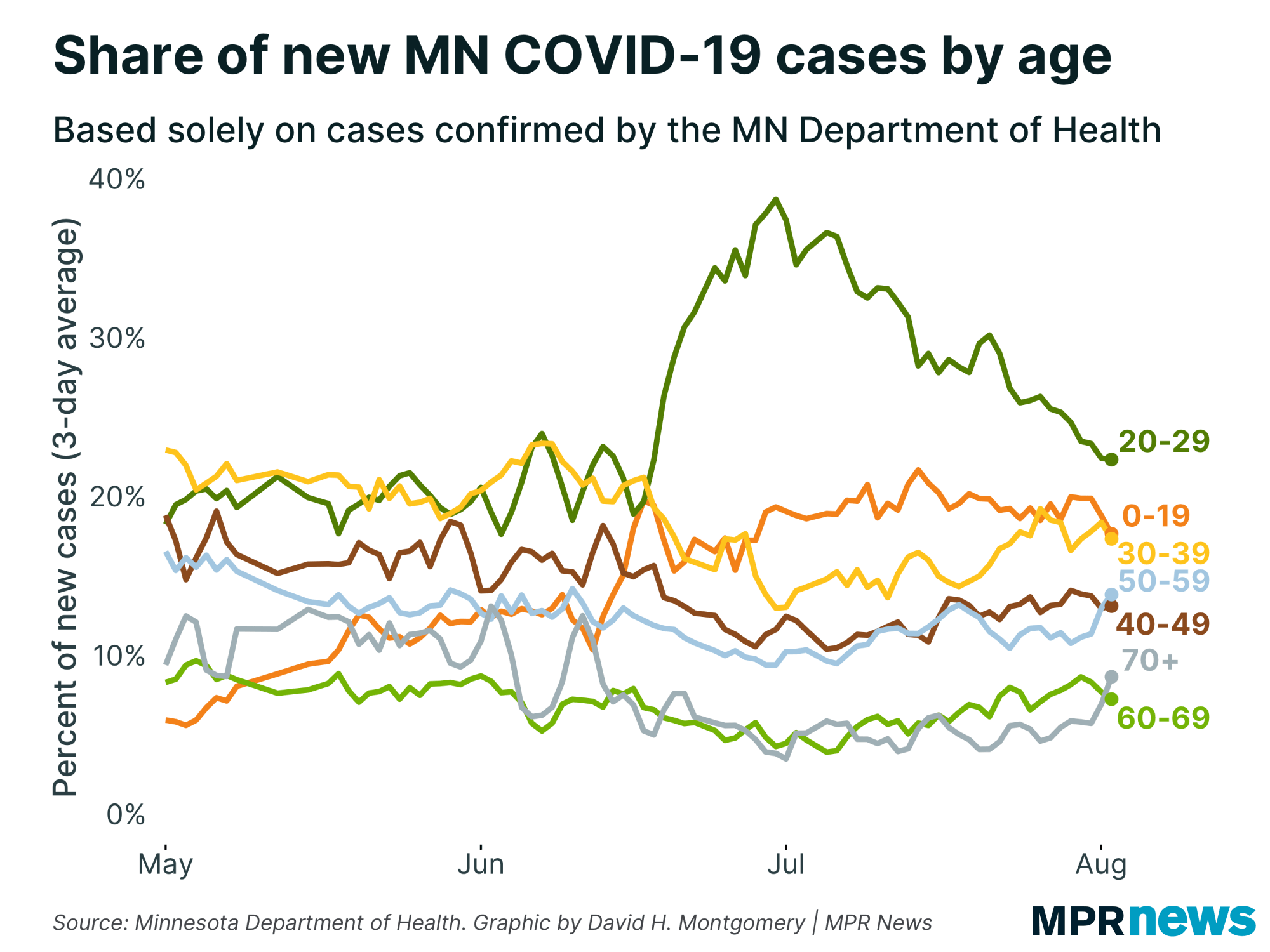The rate of positive COVID-19 tests in Minnesota inched back above 5 percent on Sunday, as the state reported eight more deaths from the disease.
The percentage of positive tests — 5.3 percent in Sunday’s report from the state Department of Health — is one of the key metrics officials are monitoring as they track the spread of the coronavirus in Minnesota.
It’s been relatively stable over the past week, just below or above the 5 percent mark. That’s up from a month ago, but still far below the peak seen in early May.
The number of people hospitalized with COVID-19 dropped in the latest report, from 317 on Saturday to 302 on Sunday. But the number remains higher than a week ago, and has trended upward over the course of several weeks.
The number of those patients being treated in ICUs was unchanged Sunday, but also has been trending upward.

Minnesota reported 769 new confirmed cases in Sunday’s report, based on 14,645 completed tests. That’s a slight increase in cases and a slight decrease in test results compared to Saturday’s report.
The number of new cases reported each day has been relatively stable over the past week. The overall number of confirmed cases is now 55,497.
The eight additional deaths reported Sunday included five residents of long-term care facilities, and three people who lived in private homes. They ranged in age from their 30s to over 100. The statewide death toll is now 1,614.
About 87 percent of people diagnosed with COVID-19 in Minnesota have recovered to the point where they no longer need to be isolated.

Here are the latest coronavirus statistics:
-
55,947 cases confirmed (769 new) via 1,054,962 tests
-
1,614 deaths (8 new)
-
5,241 cases requiring hospitalization
-
302 people remain hospitalized; 149 in intensive care
-
48,847 patients no longer requiring isolation
Cases growing across age brackets, up north
Worries remain about the growth of coronavirus cases in younger Minnesotans, including that those infected will inadvertently spread the virus to grandparents and other more vulnerable populations.
Minnesotans in their 20s now make up the age group with the most confirmed cases in the pandemic — nearly 13,000. The median age of Minnesotans infected has been trending down in recent weeks and is now 36 years old.

Investigators continue to see rising cases with bars and restaurants at their center and are examining outbreaks in 28 establishments, Ehresmann said this week.
“Consider all the roles you play” in all daily interactions, she cautioned, noting that people who might not worry about themselves should worry about infecting vulnerable family members and coworkers.
Regionally, newly reported cases have been driven recently by the Twin Cities and its suburbs, but it’s present in all parts of the state, including the north, which had largely avoided the outbreak until recently.

Cases in Beltrami County, home to Bemidji, have more than doubled in the past week and a half, increasing to 191 as of Sunday.
Ehresmann last week said the Beltrami case increase is tied to spread from athletic events and other public gatherings. Most of the state’s latest hot spots for the disease are in northern and central Minnesota.

Meatpacking operations had been hot spots for big outbreaks in southwest, west-central and central Minnesota earlier in the pandemic, but new cases have slowed considerably in recent weeks.

Developments from around the state
COVID-19 hit to state budget may last years
The COVID-19 pandemic could put a big dent in future state budgets.
A planning estimate released Friday by state finance officials shows a $4.7 billion revenue shortfall in fiscal years 2022 and 2023 because of the economic slowdown triggered by the pandemic.
The state is already facing a more a $2.3 billion deficit this biennium, but Minnesota Management and Budget Commissioner Myron Frans said the financial situation could change depending on the course of the virus.
“We need to see what’s going to happen with COVID-19 this fall,” Frans said. “And that also gives us some time to plan and make sure we make really smart strategic decisions before we have to make the long term budget decisions we’ll have to face for ’22 and ’23.”
The long-term outlook does not include any additional money the federal government might send to the states.
— Brian Bakst | MPR News
Top headlines
End of federal $600 unemployment benefit leaves Minnesotans anxious: Tens of thousands of Minnesotans who have lost their jobs due to the coronavirus pandemic have relied on an extra $600 weekly unemployment payment from the federal government to make ends meet. But that extra cash benefit expires Friday.
For Minnesotans, Walz’s school plan brings more questions than answers: With little more than guidance from the state government for how to handle the upcoming school year, many Minnesotans remain in limbo for how their lives will look in a month.
Minnesota’s rules for going back to school: State officials announced their long-awaited guidelines for how public and charter schools should plan to reopen for fall instruction in the midst of the coronavirus pandemic. What will that mean for your family, your work or your community? Here’s what you need to know.
As schools look ahead to fall, one Rochester elementary offers a glimpse of the future: Now that schools have guidance on reopening from the state, one Rochester, Minn., elementary is already in session, providing a glimpse of what the classroom could look like for many in September.
COVID-19 in Minnesota
Data in these graphs are based off Minnesota Department of Health cumulative totals released at 11 a.m. daily. You can find more detailed statistics on COVID-19 at the Health Department website.
The coronavirus is transmitted through respiratory droplets, coughs and sneezes, similar to the way the flu can spread.